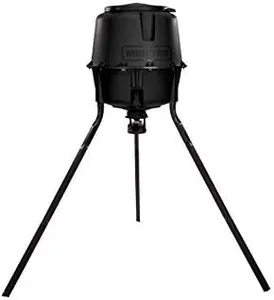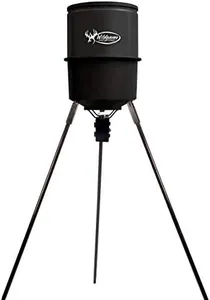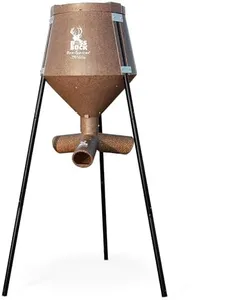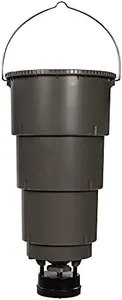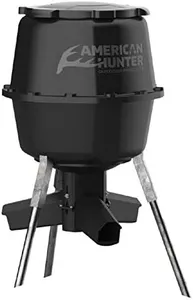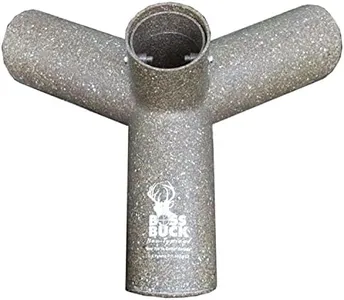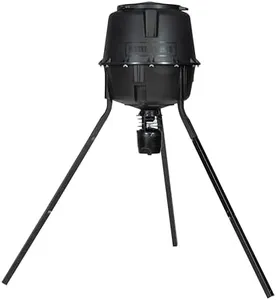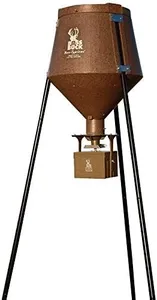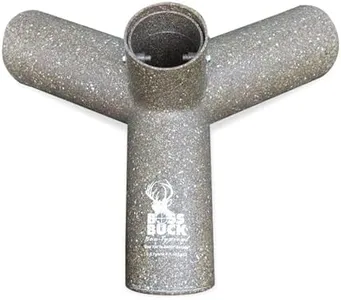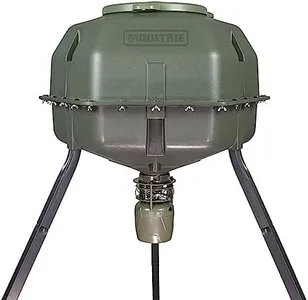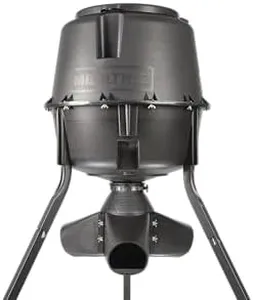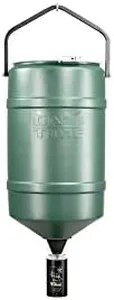10 Best Automatic Deer Feeders 2025 in the United States
Our technology thoroughly searches through the online shopping world, reviewing hundreds of sites. We then process and analyze this information, updating in real-time to bring you the latest top-rated products. This way, you always get the best and most current options available.

Our Top Picks
Winner
Moultrie 30-Gallon Deer Feeder Tripod - Moultrie Quick-Lock Hopper System - Digital Timer Control - 200 lb Feed Capacity - Durable Polymer Build - Metal Spin Plate
Most important from
3096 reviews
The Moultrie 30-Gallon Deer Feeder is designed for hunters and outdoor enthusiasts aiming to attract deer efficiently. With a generous capacity of up to 200 pounds of feed and a robust metal spin plate, it ensures even distribution, which is essential for drawing in game. The quick-lock technology simplifies setup, making it easier for users who may not be particularly handy. Additionally, the digital timer allows for customizable feeding schedules, up to four times a day, which can be tailored between 1 to 20 seconds to suit your needs.
One of the standout features is its weather-resistant design, ensuring durability against the elements, a must-have for outdoor equipment. It operates on 4 AA batteries (not included), which may require periodic replacements, so keep that in mind for long-term use.
Despite its strengths, there are a few drawbacks. Some users have reported that while the feeder is generally reliable, the battery-powered mechanism may not be as consistent compared to solar-powered alternatives, especially during colder months when battery life can diminish. Additionally, while the capacity is adequate for many, heavy users may find themselves refilling it more often than desired.
Most important from
3096 reviews
WILDGAME INNOVATIONS Quick-Set 225 lb Game Feeder with Digital Timer | Durable Tripod Corn/Pellet Hunting Feeder with 1-4 Available Feed Times & 30-feet Radius
Most important from
3021 reviews
The Wildgame Innovations Quick-Set 225 lb Game Feeder stands out in the automatic deer feeder category with its robust features designed to attract game effectively. One of its key strengths is the large 225-pound capacity, allowing for ample feed storage without frequent refills. The built-in funnel promotes accurate feed dispersal, which minimizes waste and ensures that deer are attracted to the feeding area. The digital timer is a notable feature, offering customizable feeding schedules with up to four daily times, ensuring you can optimize your hunting strategy based on deer activity.
Durability is another advantage, as this feeder is constructed with heavy-duty coated legs and a galvanized steel spinner plate. This design is meant to withstand various weather conditions, making it suitable for long-term outdoor use. The product also boasts ease of assembly, which allows users to set it up in about 15-20 minutes, a convenient feature for those who may not be very handy.
There are a few drawbacks to consider. Some users have noted that the feed distribution radius could be more effective, especially in larger areas. Additionally, the feeder operates on a manual power source, which might require you to replace batteries regularly, depending on usage. It weighs 34.4 pounds, which might be heavy for some to move around easily, though its design is made to be somewhat portable.
Most important from
3021 reviews
Boss Buck 200 lb Durable Plastic Wildlife Gravity Hunting Game Feeder w/Adjustable Flow
Most important from
494 reviews
The Boss Buck 200 lb Durable Plastic Wildlife Gravity Hunting Game Feeder is a solid choice for deer hunters looking to attract wildlife efficiently. With a capacity of 200 lbs, it accommodates a variety of non-salt-based feeds such as corn and protein pellets, making it versatile for different feeding strategies. The adjustable 3-way flow control feature is particularly beneficial, allowing users to customize the feed distribution to suit various feed types and sizes, thus enhancing its effectiveness in attracting deer.
Durability is a strong point of this feeder, as it is made from tough, weatherproof roto-molded plastic and galvanized metal hardware. This construction withstands outdoor elements, ensuring that it remains functional even in harsh weather conditions. Additionally, its slow-feed ports promote responsible feeding practices by minimizing waste, allowing multiple animals to feed at once, and fostering a healthier feeding environment.
There are a few drawbacks to consider. While the tripod design offers stability, setting it up may require some effort due to its size and assembly. Also, being a gravity feeder, it does not come with a timed distribution system, which could limit convenience for users who prefer automated feeding schedules. The feeder's design, although effective, does not integrate advanced features like digital timers or remote control functionalities that some users might expect in high-end models.
Most important from
494 reviews
Buying Guide for the Best Automatic Deer Feeders
Choosing the right automatic deer feeder can significantly enhance your wildlife management efforts, ensuring that deer are well-fed and healthy. When selecting an automatic deer feeder, it's important to consider several key specifications to ensure it meets your needs and the needs of the deer in your area. Understanding these specifications will help you make an informed decision and select a feeder that is reliable, efficient, and suitable for your specific situation.FAQ
Most Popular Categories Right Now
